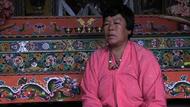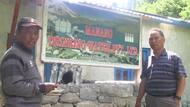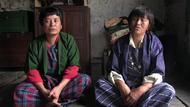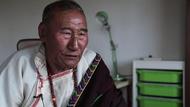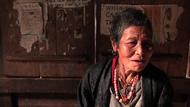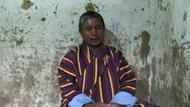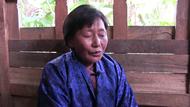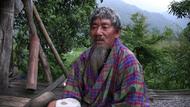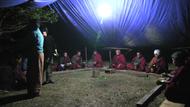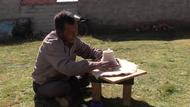Video Overview
Ngawang Jampel of Tang Gewog (county), located in Bumthang district, shares the account of the deity Indra Bodhi of Ogyencholing. He explains that the people used to say that the deity of Ogyencholing might be from neighboring country India. There is no exact evidence in support of this statement though the name Indra Bodhi is assumed to be of Indian origin. People make monthly offerings to the deity. Towards the left side of Indra's abode is another deity called Menmo. Along with the offerings made to Indra, Menmo is also made offerings by performing rituals with torma (a sort of cake). The offerings are presented mainly to appease the deities, with the wellbeing and prosperity of the villagers and the village in mind. It is not the deity of the entire Tang valley, but specifically of Ogyencholing. It is said that the deity is riding a yak, his face is white in color and he wears a hat. On the first month of the Bhutanese calendar, coinciding with the New Year, hoisting a white flag and a throne invokes the protector deity. People also make offerings to him during their annual rituals.
- Tang
- ངག་དབང་འཇམ་དཔལ་ Ngawang Jampelད་གནསཔོ་གི་ སྐོར་ལས་ཡང་ འ་ནཱེ་སྦེ་ཨིན། མ་པ་ཏེ་ ང་བཅས་ར་ སླབ་ཐངས་འབད་བ་ཅིན་ ཨིནྡྲ་བྷཱུ་དྷི་ཟེར་ མི་ལ་ལུ་གིས་ སླབ་དེས། པ་ད་ཨ་ནཱི་ ཁྱོད་ནཱ་ ཨོ་རྒྱན་ཆོས་གླིང་གི་ གནསཔོ་འདི་ ཨིནྡྲེ་ཡ་(རྒྱ་གར་)ལས་ འོང་འོངམ་འདྲས་མེན་ན་ཟེར་ཡང་ འ་ནཱེ་སྦེ་སླབ་མས། ཏེ་ག་ཅི་སྨོ་ཟེར་བ་ཅིན་ཏེ་ ཨིནྡྲ་བྷཱུ་དྷི་ཟེར་ ཨིནྡྲ་ཡ་གི་མིང་ཨིན་པས་ཟེར་ ཏེ་ ཨིནྡྲ་ཡ་ལས་ འོངམ་ཨིན་ན་ རྒྱ་ལས་འོངམ་ཨིན་ན་འདི་ ང་བཅས་ ཞུ་ནི་མེད་ཟེར་ ཞུ་ནི་ལགས།The story of deity Indra Bodhi of Ogyencholing goes like that; in fact, in one tradition some people say that the deity of Ogyencholing might have come from neighboring India. There is no exact evidence in support of the statement though but, the name Indra Bodhi assumes Indian origin and in this note, Indra Bodhi must have come from India.
- ངག་དབང་འཇམ་དཔལ་ཏེ་ནཱ་ ང་བཅས་ར་གི་ ད་རང་རང་སོའི་ གཡུས་སྒོ་རེ་རེ་ནང་ གནས་པོའི་ མཚན་རེ་རེ་འདུག་ཡོད་ལགས། འ་ནཱེ་སྦེ་ འབད་ནི་དེ་གིས་ ང་བཅས་ ནཱ་ཨོ་རྒྱན་ཆོས་གླིང་གི་ གནསཔོ་ཨིནྡྲ་བྷཱུ་དྷི་ཟེར་ འ་ནཱེ་སྦེ་ ཞུཝ་ཨིན་ལགས།
- ངག་དབང་འཇམ་དཔལ་ Ngawang Jampelཏེ་གནསཔོ་ ཨིནྡྲ་བྷཱུ་དྷི་འདི་ ཏེ་རབ་བྱུང་བ་ཅིན་ཏེ་ ཟླཝ་རེ་རེ་ནང་ ཚར་རེ་རེ་རང་ གསོལ་ཁ་ཕུལ་བའི་ཟེར་ ཞུ་ནི་ལགས། ཏེ་གནས་པོའི་ ཕར་ད་རུང་ གཡོན་ཁ་ཐུག་ལུ་ ཨ་ནཱི་ འ་་སྨན་མོ་ཟེར་ཅིག་ ད་རུང་ ཕར་ཕོ་བྲང་གཉིས་ འ་ནཱེ་ཡོད། ད་གནསཔོ་གསོལཝ་ད་ ཨིནྡྲ་བྷཱུ་དྷི་གསོལཝ་ད་ དེ་ཡང་ ཞོར་ཁར་སྦེ་ ད་གཏོརམ་ཅིག་བཞེངས་སྦེ་ ཏེ་ཕར་གྱི་ ཏེ་གནསཔོ་ཨིནྡྲ་བྷཱུ་དྷི་ དེ་ལས་ སྨན་མོ་ཟེར་We have each name of the deity for each locality. The name of our deity is called Indra Bodhi. If all conditions favor, we make offering to the deity Indra Bodhi once every month. Towards the left side of the Indra’s abode is another deity called by the name menmo. Along with the offering made to deity Indra, Deity menmo is also offered the rituals by making torma a ritual object.
- ངག་དབང་འཇམ་དཔལ་ཏེ་ང་བཅས་ ཨ་ནཱི་ ཏེ་དཔེ་ཆ་ནང་ཡང་ སྨན་མོ་ཟེར་ འ་ནཱེ་སྦེ་ཡོད། ད་འ་ནཱེ་ལུ་ཡང་ གཏོརམ་ཅིག་བཞེངས་སྦེ་ ཏེ་ཉིནམ་གཅིག་ཆོ་ག་བཏང་སྦེ་ དེ་ལས་ ཕྱི་རུ་གྲོལཝ་ད་ གནས་པོའི་གཏོརམ་འདི་ ཡར་གནས་པོའི་ ཕོ་བྲང་ཁོ་ར་གུ་བཀལ་ དེ་ལས་ སྨན་མོ་གི་ གཏོརམ་སོ་སོར་སྦེ་བཞེངས་ཏེ་ དེ་ཡང་ཏེ་ ཕར་ཁོ་ར་ ཕར་ཕོ་བྲང་ ཡོད་སར་རང་ འ་ནཱེ་སྦེ་ སྐྱེལ་བར་འགྱོ་བའི་ཟེར་ འ་ནཱེ་སྦེ་ཞུ་ནི་ལགས།
- ངག་དབང་འཇམ་དཔལ་ད་འ་ནཱི་ ཟླ་རིམ་བཞིན་དུ་ མ་ཆདཔ་སྦེ་ འ་ནཱི་གསོལ་བ་ཅིན་ ཏེ་ག་ཅི་སྨོ་ཟེར་བ་ཅིན་ ང་བཅས་ཀྱི་ཨ་ཙི་ཅིག་ ཁོ་ལུ་ གསོལཝ་བཏབ་ད་ མ་བཏབ་ འདྲ་རང་མི་འདྲ་བས་ཟེར་ ཞུ་ནི་ཨིན་ལགས།
- ངག་དབང་འཇམ་དཔལ་ Ngawang Jampelཏེ་ཁོ་ ཨ་ཙི་ཅིག་ ཡུན་རིང་སོང་པ་ཅིན་ ཏེ་ང་བཅས་ལུ་ཏེ་ ན་ནི་ཚ་ནི་དང་ དེ་ལས་ མི་ན་རུང་ ག་ཏེ་ལུ་ མོ་བཏབ་ནཱེམ་འབད་རུང་ ད་ཁྱོད་ར་ ཡར་གནསཔོ་མ་མཉེས་པས་ཟེར་ ཏེ་གནསཔོ་ གསོལ་ཁ་ཕུལ་དགོ་པས་ཟེར་ གནས་པོ་ལུ་ ནཱེམ་ཨ་་་ག་ཅི་ལོ་ ཨ་ནཱི་ གསེར་སྐྱེམས་ཕུལ་དགོ་པས་ཟེར་ འ་ནཱེ་སྦེ་རང་ ཐོན་མས་ཟེར་ ཁོ་ལུ་ ཏེ་མ་ཆདཔ་པས་རང་ གསོལ་ཁ་ ནཱེམ་ཕུལཝ་ཨིན་ཟེར་ ཞུ་ནི་ལགས།In the sacred text of offering to the deities, we perform by making torma and place it in the abode of the 2 deities. In the event of delay in making offerings, there will be cases of sickness and the people say that the deities are not appeased. So we make offerings again.
- ཌོག་ཊར་ཀརྨ་ཕུན་ཚོགས་ Dr Karma Phuntshoགནས་པོའི་སྐུ་མདོག་ ཕྱག་མཚན་What are the colors of the body and the symbolic implements of the deity?
- ངག་དབང་འཇམ་དཔལ་འ་་་གནས་པོའི་ སྐུ་མདོག་ཕྱག་མཚན་འདི་ གནས་པོ་ ཁོ་ར་ ངོ་མ་འབད་བ་ཅིན་ ཏེ་ཁོ་ གཡག་གུ་ཆིབས་ཏེ་ཡོད་པའི་ལགས། ཏེ་ཁོ་ར་ཡང་ གནས་པོ་གི་ སྐུ་མདོག་འདི་ ཞལ་དཀརཔོ་ ཏེ་ དཔེ་འབད་བ་ཅིན་ ཏེ་ད་ དབུ་ཞྭམོ་ཡང་ཡོད།
- ངག་དབང་འཇམ་དཔལ་ Ngawang Jampelཏེ་ཁོ་ ཕར་ཁོ་གི་ ཏེ་ རྒྱན་ཆས་དང་ ག་བཟུམ་ཡོདཔ་སྨོ་ཟེར་བ་ཅིན་ ཨ་ནཱ་ གླིང་གེ་སར་རྒྱལ་པོ་བཟུམ་སྦེརང་ ཏེ་ཡོད་པའི་ལགས། ད་མགོ་ལས་དབུ་གུ་ཡང་ ལྕགས་མོག་སྦེ་ དེ་ལས་ གཡག་གུ་ཆིབས་ཏེ་ ཏེ་གནམ་མེད་ས་མེད་ ཨ་ནཱེ་སྦེ་ ཁྲོ་བོ་སྦེ་ཡང་ཡོདཔ་ཨིན་ཟེར་ ཞུ་ནི་ལགས།The deity resumes King Gesar and is furious in expression.
- ཌོག་ཊར་ཀརྨ་ཕུན་ཚོགས་ Dr Karma Phuntshoགནས་པོ་གི་ས་སྒོ་Deity's abode?
- ངག་དབང་འཇམ་དཔལ་ངག་དབང་འཇམ་དཔལ:ཨ་་་ས་སྒོ་འབད་བ་ཅིན་ ཏེ་ ས་ཐང་ཡང་མེན་ལགས། ད་ད་ལྟོ་ ནཱ་ང་བཅས་ ཨ་ནཱི་ སྒྲུབ་ཕུག་ན་ཡོད་ལགས། འ་ནཱེ་སྒྲུབ་ཕུག་གི་ཕར་ ད་ཨ་་་ག་ཅི་ལོ། ཨ་ཕར་ ཨ་ཙི་ཅིག་ན ་སྦོ་ལོགས་ཁར་རང་ཨིན་ལགས། མ་པ་ལམ་འགྱོ་བ་ཅིན་ མི་ནཱཊི་(སྐར་མ་) འ་་་གཉིས་དེ་ཅིག་མ་གཏོགས་་མི་འགོར་ལགས།
- ངག་དབང་འཇམ་དཔལ་ Ngawang Jampelད་ས་གྱེལ་པ་ཨིན་ལགས། ན་སྟོང་ཕུག་དང་ ཨ་ནཱི་ ག་ཅི་ལོ་ བྱི་ཤིང་གི་ རྩ་བར་ཨིན་ལགས། ཏེ་ཁོ་ གནས་པོ་གི་ རྒྱབ་ཁར་ལས་ ཨ་ནཱི་ སྟོང་ཕུག་ཤིང་ སྦོམ་ཅིག་ཡོད་ལགས། ཏེ་ནཱེའི་ གདོང་སྐོར་ལུ་ཡང་ བྱི་ཤིང་སྦོམ་སྦེ་རང་ཡོད་ལགས།It is said that the deity is riding a yak, has a white face and is wearing a hat. The abode of deity is two minutes’ walk from where we are now.
- ངག་དབང་འཇམ་དཔལ་ Ngawang Jampelཏེ་ཁོ་ལུ་ཏེ་ ཨ་་་ཟླཝ་ག་ཅི་ལོ་ གནསཔོ་གསོལཝ་ད་ ད་རུང་ ཁོ་ལུ་ ཚོགས་གཏོརམ་བཞེངས་སྦེ་ གསོལ་ཁ་སྦེ་ དེ་ལས་ཏེ་ དར་ཅིག་ཡང་འཕྱར་ཏེ་ ལོ་གཅིག་ལུ་ ཏེ་ནཱ་ལུ་ ལོ་གསར་ཟེར་ ཟླཝ་དང་པའི་གི་ ལོ་གསརཔ་འདི་ལུ་ ཏེ་ཁོ་ལུ་ཡང་ཏེ་ ཕར་བཞུགས་ཁྲི་རྐྱབ་འབད་སྦེ་ དར་དཀརཔོ་ཅིག་ཡང་ འཕྱར་ནི་ཡོད་ལགས། དེ་ལས་On the first month of the Bhutanese calendar coinciding with the New Year, we hoist a white flag and a throne invokes the protector deity.
- ངག་དབང་འཇམ་དཔལ་ Ngawang Jampelཨ་ནཱ་ དར་དཀརཔོ་ཅིག་འཕྱར་སྦེ་ དེ་ལས་ ང་བཅས་ ཕྱག་དང་གཡུག་ཅིག་ཡང་ རྐྱབ་སྦེ་ འ་ནཱེ་སྦེ་འབད་བའི་ཟེར་ ཞུ་ནི་འབད་ཨིན་ལགས།After hosting a flag, [we] make a long noise, this is how the deity is invoked.
- ཌོག་ཊར་ཀརྨ་ཕུན་ཚོགས་ Dr Karma Phuntshoསྟང་ཡོངས་རྫོགས་ཀྱི་ གནསཔོ་ཨིན་ན?Is it the deity of entire Tang valley?
- ངག་དབང་འཇམ་དཔལ་ Ngawang Jampelའ་་་་ང་བཅས་ སྟང་ཡོངས་རྫོགས་ཀྱི་ གནསཔོ་མེན་ལགས= ང་བཅས་ ནཱ་ཨོ་རྒྱན་ཆོས་གླིང་ རྐྱངམ་ཅིག་ཨིན་ལགས། ཏེ་ཕར་དང་ཚུར་ ད་རེས་ནངས་པ་ རོགས་ ག་ཅི་སོ་སོར་སྡོད་རུང་ ཏེ་གཡུས་སྒོ་ སོ་སོར་སྡོད་དེ་རང་འབད་རུང་ སྔོན་མ་ ནང་ཨོ་རྒྱན་ཆོས་གླིང་ལུ་ སྡོད་མི་ཚུ་ འབད་བ་ཅིན་It is not the deity of the entire Tang valley, but the deity of Ogyencholing. The people whose origin is from Ogyencholing make offerings to the deity wherever they are.
- ངག་དབང་འཇམ་དཔལ་ཏེ་ད་རེས་ནངས་པ་ ཁོང་ར་གིས་ཡང་ ཨ་ནཱི་ ལོ་གཅིག་ལུ་ ལོ་མཆོད་བཏངམ་ད་ཏེ་ གཏོརམ་གི་གྲལ་ཁར་ ཨ་ནཱ་ གནས་པོ་ཨིནྡྲ་བྷཱུ་དྷི་གི་ གཏོརམ་སྦེ་བཙུགསཔ་ཨིན་ལགས། ག་ཅི་སྨོ་ཟེར་བ་ཅིན་ སྔོན་མ་ སྦོམ་ས་སྐྱེས་ས་ཏེ་ག་ར་ ནཱ་ཨོ་རྒྱན་ཆོས་གླིང་འབད་ནི་དེ་གིས་ཏེ་
- ངག་དབང་འཇམ་དཔལ་ངའ་ནཱི་ རང་གྱི་ སྐྱེས་ལྷ་ཡུལ་ལྷ་ཟེར་ འ་ནཱེ་སྦེ་ཏེ་ ཁོང་རང་ ད་རེས་ནངས་པ་ སྡོད་ས་ག་ཏེ་རང་འབད་རུང་ ཏེ་ཨ་ནཱི་ གནསཔོ་ཨིནྡྲ་བྷཱུ་དྷི་ཏེ་ ཁོང་རང་གི་ སྐྱེས་ལྷ་འབད་ནི་དེ་ ཁོང་རང་གི་ ཆོས་སྲུང་གི་ ཨ་ནཱི་གཏོརམ་གི་ གྲལ་ཁར་བཙུགས་ཏེ་ དེ་སྦེ་རང་ གསོལ་ཁ་ཕུལ་བའི་ཟེར་ ཞུ་ནི་ཨིན་ལགས།The people of Ogyencholing make the offerings to the Indra Bodhi at the time of the annual ritual as place being their origin, wherever they live.
 Loading ...
Loading ... 